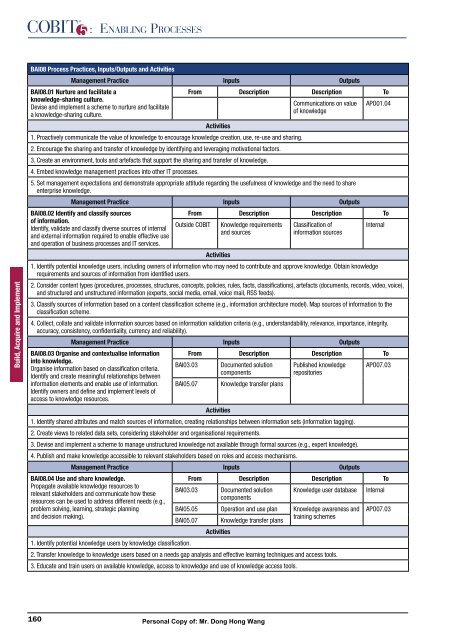Enabling Processes
Enabling Processes
Enabling Processes
Create successful ePaper yourself
Turn your PDF publications into a flip-book with our unique Google optimized e-Paper software.
Build, Acquire and Implement<br />
160<br />
: ENABLING PROCESSES<br />
BAI08 Process Practices, Inputs/Outputs and Activities<br />
Management Practice Inputs Outputs<br />
BAI08.01 Nurture and facilitate a<br />
From Description Description To<br />
knowledge-sharing culture.<br />
Devise and implement a scheme to nurture and facilitate<br />
a knowledge-sharing culture.<br />
Activities<br />
Communications on value<br />
of knowledge<br />
APO01.04<br />
1. Proactively communicate the value of knowledge to encourage knowledge creation, use, re-use and sharing.<br />
2. Encourage the sharing and transfer of knowledge by identifying and leveraging motivational factors.<br />
3. Create an environment, tools and artefacts that support the sharing and transfer of knowledge.<br />
4. Embed knowledge management practices into other IT processes.<br />
5. Set management expectations and demonstrate appropriate attitude regarding the usefulness of knowledge and the need to share<br />
enterprise knowledge.<br />
Management Practice Inputs Outputs<br />
BAI08.02 Identify and classify sources<br />
From Description Description To<br />
of information.<br />
Identify, validate and classify diverse sources of internal<br />
and external information required to enable effective use<br />
and operation of business processes and IT services.<br />
Outside COBIT Knowledge requirements<br />
and sources<br />
Classification of<br />
information sources<br />
Internal<br />
Activities<br />
1. Identify potential knowledge users, including owners of information who may need to contribute and approve knowledge. Obtain knowledge<br />
requirements and sources of information from identified users.<br />
2. Consider content types (procedures, processes, structures, concepts, policies, rules, facts, classifications), artefacts (documents, records, video, voice),<br />
and structured and unstructured information (experts, social media, email, voice mail, RSS feeds).<br />
3. Classify sources of information based on a content classification scheme (e.g., information architecture model). Map sources of information to the<br />
classification scheme.<br />
4. Collect, collate and validate information sources based on information validation criteria (e.g., understandability, relevance, importance, integrity,<br />
accuracy, consistency, confidentiality, currency and reliability).<br />
Management Practice Inputs Outputs<br />
BAI08.03 Organise and contextualise information From Description Description To<br />
into knowledge.<br />
Organise information based on classification criteria.<br />
Identify and create meaningful relationships between<br />
BAI03.03 Documented solution<br />
components<br />
Published knowledge<br />
repositories<br />
APO07.03<br />
information elements and enable use of information.<br />
Identify owners and define and implement levels of<br />
access to knowledge resources.<br />
BAI05.07 Knowledge transfer plans<br />
Activities<br />
1. Identify shared attributes and match sources of information, creating relationships between information sets (information tagging).<br />
2. Create views to related data sets, considering stakeholder and organisational requirements.<br />
3. Devise and implement a scheme to manage unstructured knowledge not available through formal sources (e.g., expert knowledge).<br />
4. Publish and make knowledge accessible to relevant stakeholders based on roles and access mechanisms.<br />
Management Practice Inputs Outputs<br />
BAI08.04 Use and share knowledge.<br />
From Description Description To<br />
Propagate available knowledge resources to<br />
relevant stakeholders and communicate how these<br />
resources can be used to address different needs (e.g.,<br />
BAI03.03 Documented solution<br />
components<br />
Knowledge user database Internal<br />
problem solving, learning, strategic planning<br />
BAI05.05 Operation and use plan Knowledge awareness and APO07.03<br />
and decision making).<br />
BAI05.07 Knowledge transfer plans<br />
Activities<br />
training schemes<br />
1. Identify potential knowledge users by knowledge classification.<br />
2. Transfer knowledge to knowledge users based on a needs gap analysis and effective learning techniques and access tools.<br />
3. Educate and train users on available knowledge, access to knowledge and use of knowledge access tools.<br />
Personal Copy of: Mr. Dong Hong Wang


